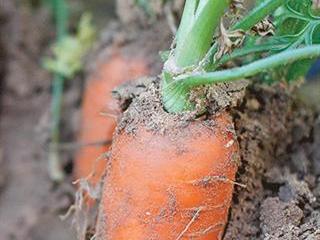
No chemicals have been registered for the control of common pests and diseases in carrots. So other strategies are required.
Pests
Nematodes: Root-knot nematodes (Meloidogyne spp.) can cause serious losses. Symptoms include thickened taproots and lateral roots, and split and forked roots. Summer’s higher soil temperature favours development of the pest. Various soil fumigants may be used before planting to control nematodes. Other pests: False wireworms, cutworms and millipedes sometimes damage the roots. Harvest earlier when damage occurs late in growth. Crop rotation and frequent working of the soil should reduce these problems.
Diseases
Alternaria leaf blight (Alternaria dauci): This common disease of carrots in KwaZulu-Natal occurs mainly during wet weather in summer, with prolonged heavy dews promoting severe outbreaks in some areas. Dark brown to black spots, some with a yellow edge, appear on the leaves. At first, the spots appear mainly on the leaf edges, where they merge, giving the leaves a scorched look. The fungus can be transmitted with the seed, and may cause damping-off of seedlings.
To control leaf blight, plant tolerant cultivars or seed certified disease-free. In areas where blight is a problem, avoid planting in lands where foliage won’t dry quickly after rain or dew, or don’t plant at times of the year when the disease is more prevalent. Also, implement a strict crop rotation programme.Bacterial blight (Xanthomonas carotae): Likes warm, wet weather.
Symptoms are easily confused with Alternaria, but this disease is less common. Signs include irregular brown spots on the leaves, brown strips on the petioles and long brown horizontal lesions on the roots. Plant disease-free seed. White mould (Sclerotinia sclerotiorum): More common in lush, dense plantings and will often start where plants have been trampled or otherwise injured. Cool, wet conditions favour the disease.
A white cottony growth develops on parts of the plant above the ground. The shoulders of the roots may also become infected and plant tissue becomes soft and watery. The disease can develop in harvested carrots packed for the market.
For disease control, practice a three-year rotation with non-susceptible crops. (Other vegetables susceptible to infection include green beans, lettuce and tomatoes.) Remove and destroy infected crop residue. Plant on ridges to improve drainage and enable the soil surface to dry more rapidly.













